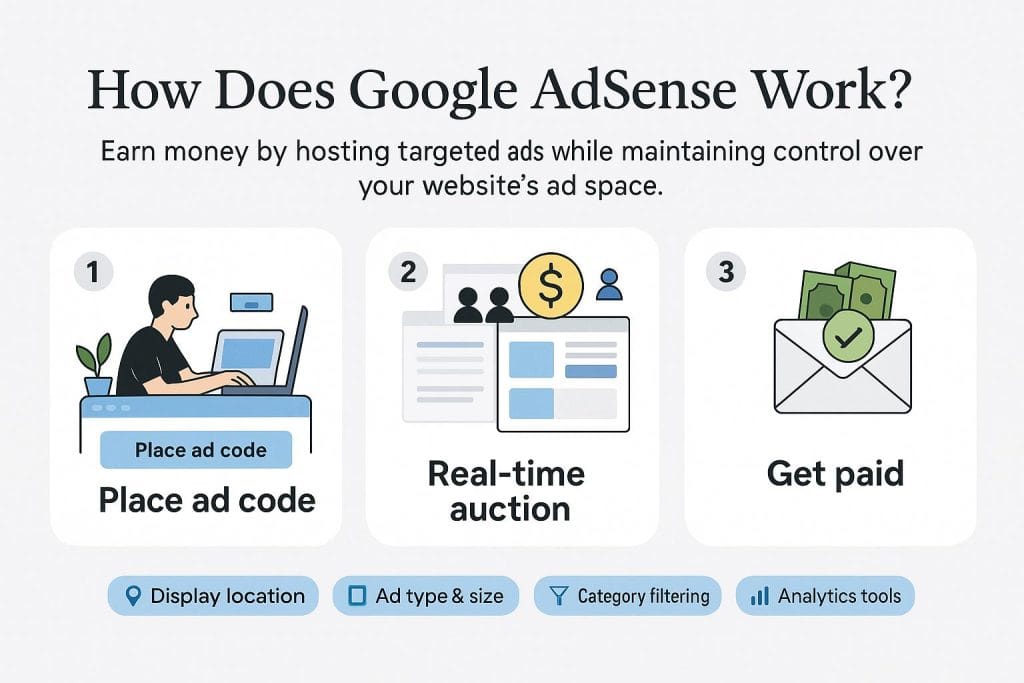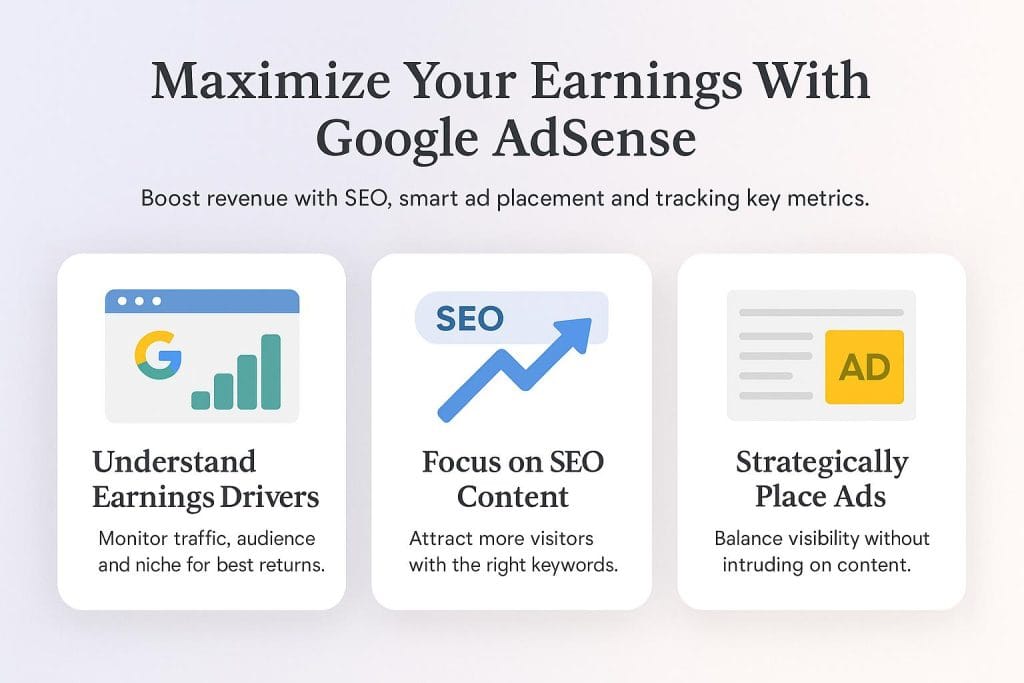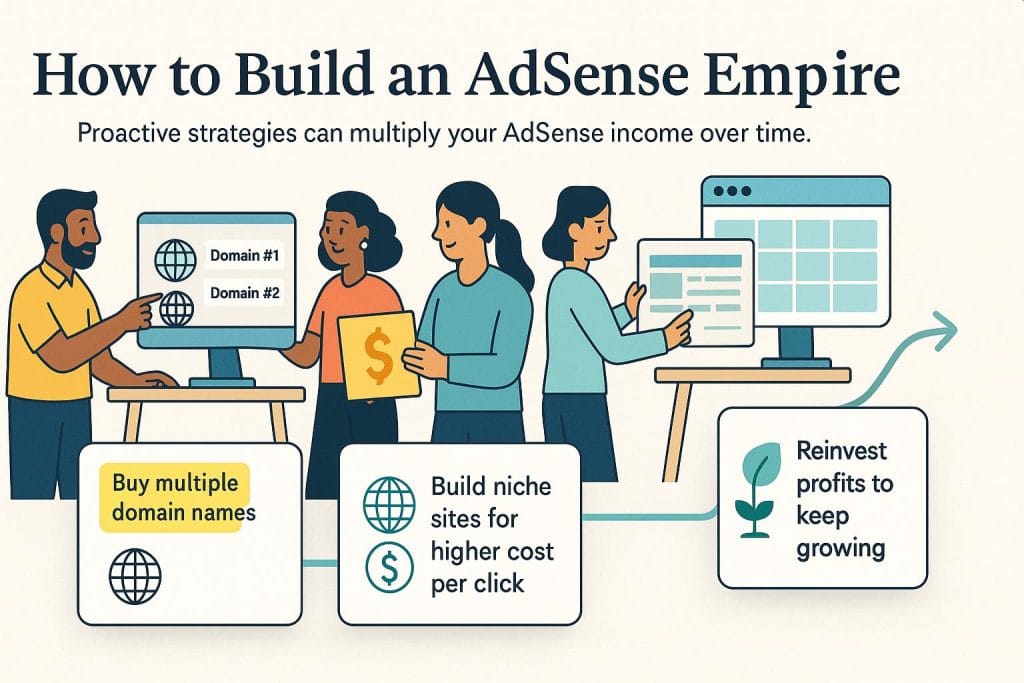Business.com aims to help business owners make informed decisions to support and grow their companies. We research and recommend products and services suitable for various business types, investing thousands of hours each year in this process.
As a business, we need to generate revenue to sustain our content. We have financial relationships with some companies we cover, earning commissions when readers purchase from our partners or share information about their needs. These relationships do not dictate our advice and recommendations. Our editorial team independently evaluates and recommends products and services based on their research and expertise. Learn more about our process and partners here.
Make Money with Google AdSense: Everything to Know to Grow an Empire
Expand online earnings with Google AdSense, a straightforward program for monetizing your website through user-clicked ads.

Table of Contents
In today’s digital world, entrepreneurs and small business owners often explore multiple revenue streams as part of their online marketing plans. One of the most popular options is Google’s AdSense program.
Google AdSense provides a simple, free way to monetize your website or online content. By integrating AdSense, you can display ads and earn money every time a user clicks on one. Here’s how the program works and how you can start making money with Google AdSense today.
What is Google AdSense?

AdSense is a free Google program that helps website owners and content creators make money by placing relevant ads on their sites. Every time a visitor views or clicks an ad, the publisher earns revenue, making AdSense one of the easiest ways to monetize an online business. While Google doesn’t publicly share an official publisher count, BuiltWith estimates that more than 49 million websites use Google AdSense.
Website owners can also place Google search boxes on their web pages. When visitors use the search box, Google places ads accurately based on the visitor’s search terms.
Google’s algorithms analyze each website’s content to match it with relevant ads from Google’s advertiser network. That way, the ads shown through AdSense are more likely to appeal to visitors and generate revenue for the publisher. For example, a travel blog might display ads for flights or vacation packages.
Google strictly enforces high standards. Before allowing any ads to be displayed, its automated systems and human reviewers ensure everything is in compliance with the company’s policies. The platform also uses machine learning to spot issues early and keep ads professional and brand-safe. According to Google’s Ad Safety Report, the system blocked or removed about 5.1 billion ads in 2024 and suspended 39.2 million advertiser accounts for policy violations.
What is the difference between Google AdSense and Google Ads?
Google AdSense and Google Ads work together in Google’s advertising ecosystem, but serve different roles. AdSense is built for website owners and content creators who want to earn money from their online traffic. It lets publishers show ads on their pages and earn revenue when visitors view or click them.
In contrast, Google Ads (formerly Google AdWords) is designed for businesses and marketers who want to promote their products or services using a pay-per-click (PPC) strategy, where advertisers pay only when someone clicks their ad. With Google Ads, you can build and manage campaigns that appear on Google Search, YouTube and partner websites. The platform lets you control your budget, choose the right keywords and reach the audiences most likely to become customers.
How does Google AdSense work?

After signing up for AdSense on Google’s AdSense page, the setup process comes down to three main steps:
- Make space for ads: Add a small piece of ad code where you’d like Google to display ads on your website.
- Let advertisers bid: Google runs a real-time auction where advertisers compete for your available ad space. The highest bidder’s ad appears on your site.
- Get paid: Google manages the billing and payments so you can focus on creating content while earning revenue.
AdSense also lets publishers customize how ads appear on their sites. You can control:
- Where to display ads
- How ads are organized on the page
- The types of ads to include
- Ad sizes and formats
- Categories of ads to show or block
AdSense also comes with tools to help you get more from your ads. You can monitor performance as it happens, get guidance when you need it, and link your account with Google Ad Manager or Google Analytics 4 to see how your audience engages with your content.
How do you make money from Google AdSense?

The more people who visit your site, the more likely users are to click on Google Ads and generate AdSense income for your business.
Still, your journey to AdSense success may not be quick. While some website owners achieve rapid traffic growth and viral reach, most publishers build their revenue gradually through strategic content development and audience growth. According to Ranktracker’s 2025 AdSense data, U.S. publishers in high-demand niches such as finance, technology and legal services typically see RPMs between $20 and $50. Actual earnings vary widely based on niche, traffic quality, ad placement and seasonal trends.
Many successful publishers diversify their strategy by launching multiple niche websites or expanding their content verticals. That said, persistence pays off.
“It was slow going our first month … we spent around $2,000 … and made a grand total of $32.89 … ouch!” recalled Justin Cooke, co-founder and chief marketing officer of Empire Flippers and co-founder of WebStreet. “A few months later and we realized we were onto something that would be a profitable project for us. We started to sell off some of our niche sites to fund increased growth and [grew] the revenue to just over $20,000 per month on average.”
Best practices for making money with Google AdSense
If you want to earn as much as possible from AdSense, focus on the factors that most influence revenue: your traffic, your content and your ad strategy.
- Understand your earning potential: AdSense revenue can vary widely based on your website’s traffic volume, audience demographics, content niche and even the time of year. You can use Google’s AdSense revenue calculator to estimate potential income based on your metrics. Actual earnings come from either cost-per-click (CPC) or cost-per-thousand-impressions (CPM) models. CPC rates typically range from $0.20 to $15 per click, depending on the industry.
- Create high-quality, search-optimized content: Strong content is still the foundation of any successful AdSense strategy. Write pieces that answer real user questions, include relevant long-tail keywords naturally and follow a consistent publishing schedule. Tools like Google Search Console can help you identify which search queries bring readers to your site so you can refine your content strategy.
- Be strategic with ad placement: Where you position ads affects both user experience and revenue. Google’s Auto ads use machine learning to optimize placement automatically, but manual positioning — especially above the fold or within content — often leads to higher engagement while keeping your Core Web Vitals scores healthy.
- Optimize for mobile and user experience: More than half of web traffic now comes from mobile devices, so your site’s mobile layout and loading speed play a major role in ad performance. Use responsive web design, compress images and test your site’s layout across devices to make sure ads display cleanly without crowding your content.
- Monitor and test performance regularly: AdSense success isn’t a “set it and forget it” process. Review your analytics dashboard often to see which pages, ad types and placements perform best. Run A/B tests on layouts or ad formats, and use those insights to fine-tune your strategy over time. Even small adjustments can lead to noticeable improvements in RPM.
By focusing on these best practices, you’ll create a stronger foundation for steady traffic, better engagement and higher AdSense earnings over time.
How do you create an AdSense empire?

Building a thriving AdSense business takes strategy, patience and consistency. While some publishers are happy earning passive income from a single site, those who want to scale their results treat AdSense like a true portfolio business. Here’s how the most successful “empire builders” do it:
- Research and acquire smart domains: Top publishers often research and acquire domains aligned with underserved niches. “Create niche sites or blogs that are built specifically with AdSense in mind and targeted around profitable AdSense keywords,” Cooke advised. “You’ll find a much higher cost per click with this microtargeting.” Profitable publishers also tend to build authority sites with rich, useful content rather than thin or filler pages. Using a top web hosting service and a strong SEO strategy is also crucial for driving traffic.
- Build authority, not thin content: Instead of spinning up dozens of low-effort sites, successful AdSense publishers focus on creating authority sites with in-depth, valuable content. They develop comprehensive resources that meet user needs and weave ads in naturally so they enhance rather than interrupt the reading experience.
- Reinvest to scale: Many publishers choose to reinvest a substantial portion of their AdSense revenue — often in the range of 30 to 50 percent — into content, technical upgrades and site expansion. This reinvestment fuels faster traffic growth and long-term profitability.
- Manage cash flow wisely: AdSense runs on a monthly payment cycle with a $100 minimum threshold. Payments usually arrive around the 21st of each month for the previous month’s earnings — meaning there’s a 30- to 50-day delay between earning and receiving revenue. Keeping this in mind helps publishers plan their cash flow and reinvestment timing.
What are the pros and cons of Google AdSense?

Google AdSense can be a great way for entrepreneurs and website owners to earn extra income, but it also comes with a few challenges to keep in mind.
Pros
- Advanced ad targeting: Google’s machine learning technology analyzes page content, user behavior and contextual signals to deliver ads that are highly relevant to your audience. This precise targeting often leads to click-through rates two to three times higher than standard display advertising.
- Flexible design and customization: AdSense offers responsive ad units that automatically adjust to different screen sizes and layouts, ensuring your ads look great across devices. You can also customize colors, fonts and styles to match your brand while maintaining strong performance.
- Detailed performance insights: AdSense gives publishers access to a comprehensive analytics dashboard with metrics like RPM, CTR, viewability scores and revenue breakdowns by ad unit, page and location. Ranktracker’s 2025 data estimates that the average global AdSense RPM is around $10 to $20, with top-performing sites in competitive niches earning $50 or more.
Cons
- Language limitations: As of 2025, AdSense supports 50 languages, which may limit publishers targeting regional or multilingual audiences.
- Verification delays: Google requires all publishers to complete identity and address verification before receiving payments. This process can delay the first payout by several weeks for new accounts.
- Potential performance slowdowns: Ad scripts can affect Core Web Vitals metrics like Largest Contentful Paint (LCP) and Cumulative Layout Shift (CLS). It’s important to monitor page-load speed and use lazy loading to maintain strong site performance.
- Strict policy enforcement: Google has a zero-tolerance policy for invalid traffic and violations. Accounts can be suspended for click fraud, even when caused by third parties. Using traffic monitoring tools and maintaining high-quality content standards is essential for long-term account security.
Despite these cons, business owners can still enjoy an excellent return on investment by utilizing AdSense and sticking to their strategy. With patience and consistent effort, AdSense can become a reliable source of long-term revenue.
“It’s important to know that you’re not going to be able to get started without some risk,” Cooke said. “You’re going to have to invest some time and some money to test things out, get your process worked out, etc.”
Source interviews were conducted for a previous version of this article.










